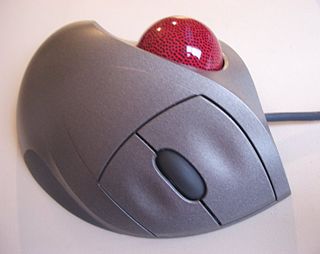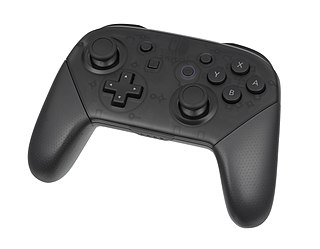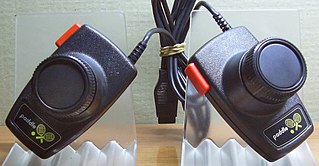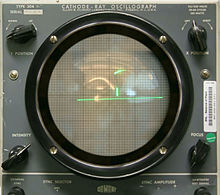
An analog computer or analogue computer is a type of computer that uses the continuous variation aspect of physical phenomena such as electrical, mechanical, or hydraulic quantities to model the problem being solved. In contrast, digital computers represent varying quantities symbolically and by discrete values of both time and amplitude.

A joystick, sometimes called a flight stick, is an input device consisting of a stick that pivots on a base and reports its angle or direction to the device it is controlling. A joystick, also known as the control column, is the principal control device in the cockpit of many civilian and military aircraft, either as a centre stick or side-stick. It has various switches to control functions of the aircraft controlled by the Pilot and First Officer of the flight.

A trackball is a pointing device consisting of a ball held by a socket containing sensors to detect a rotation of the ball about two axes—like an upside-down ball mouse with an exposed protruding ball. Users roll the ball to position the on-screen pointer, using their thumb, fingers, or the palm of the hand, while using the fingertips to press the buttons.

A video game console is an electronic device that outputs a video signal or image to display a video game that can be played with a game controller. These may be home consoles, which are generally placed in a permanent location connected to a television or other display devices and controlled with a separate game controller, or handheld consoles, which include their own display unit and controller functions built into the unit and which can be played anywhere. Hybrid consoles combine elements of both home and handheld consoles.

The Magnavox Odyssey is the first commercial home video game console. The hardware was designed by a small team led by Ralph H. Baer at Sanders Associates, while Magnavox completed development and released it in the United States in September 1972 and overseas the following year. The Odyssey consists of a white, black, and brown box that connects to a television set, and two rectangular controllers attached by wires. It is capable of displaying three square dots and one line of varying height on the screen in monochrome black and white, with differing behavior for the dots depending on the game played. Players place plastic overlays on the screen to display additional visual elements for each game, and one or two players for each game control their dots with the knobs and buttons on the controller by the rules given for the game. The console cannot generate audio or track scores. The Odyssey console came packaged with dice, paper money, and other board game paraphernalia to accompany the games, while a peripheral controller—the first video game light gun—was sold separately.

A game controller, gaming controller, or simply controller, is an input device or input/output device used with video games or entertainment systems to provide input to a video game. Input devices that have been classified as game controllers include keyboards, mice, gamepads, and joysticks, as well as special purpose devices, such as steering wheels for driving games and light guns for shooting games. Controllers designs have evolved to include directional pads, multiple buttons, analog sticks, joysticks, motion detection, touch screens and a plethora of other features.

William Alfred Higinbotham was an American physicist. A member of the team that developed the first nuclear bomb, he later became a leader in the nonproliferation movement. He also has a place in the history of video games for his 1958 creation of Tennis for Two, the first interactive analog computer game and one of the first electronic games to use a graphical display.

A gamepad is a type of video game controller held in two hands, where the fingers are used to provide input. They are typically the main input device for video game consoles.

A paddle is a game controller with a round wheel and one or more fire buttons, where the wheel is typically used to control movement of the player object along one axis of the video screen. A paddle controller rotates through a fixed arc ; it has a stop at each end.

OXO is a video game developed by A S Douglas in 1952 which simulates a game of noughts and crosses (tic-tac-toe). It was one of the first games developed in the early history of video games. Douglas programmed the game as part of a thesis on human-computer interaction at the University of Cambridge.

An electronic game is a game that uses electronics to create an interactive system with which a player can play. Video games are the most common form today, and for this reason the two terms are often used interchangeably. There are other common forms of electronic game including handheld electronic games, standalone systems, and exclusively non-visual products.

Electronic media are media that use electronics or electromechanical means for the audience to access the content. This is in contrast to static media, which today are most often created digitally, but do not require electronics to be accessed by the end user in the printed form. The primary electronic media sources familiar to the general public are video recordings, audio recordings, multimedia presentations, slide presentations, CD-ROM and online content. Most new media are in the form of digital media. However, electronic media may be in either analogue electronics data or digital electronic data format.

The APF TV Fun brand is a series of dedicated home video game consoles manufactured by APF Electronics Inc. and built in Japan starting in 1976. The systems were among the first built on the General Instrument "Pong-on-a-chip", the AY-3-8500, that allowed many manufacturers to compete against the Atari Home Pong. The APF TV Fun consoles were one of the earliest Pong clone consoles.

A vector monitor, vector display, or calligraphic display is a display device used for computer graphics up through the 1970s. It is a type of CRT, similar to that of an early oscilloscope. In a vector display, the image is composed of drawn lines rather than a grid of glowing pixels as in raster graphics. The electron beam follows an arbitrary path, tracing the connected sloped lines rather than following the same horizontal raster path for all images. The beam skips over dark areas of the image without visiting their points.

An oscilloscope is a type of electronic test instrument that graphically displays varying voltages of one or more signals as a function of time. Their main purpose is capturing information on electrical signals for debugging, analysis, or characterization. The displayed waveform can then be analyzed for properties such as amplitude, frequency, rise time, time interval, distortion, and others. Originally, calculation of these values required manually measuring the waveform against the scales built into the screen of the instrument. Modern digital instruments may calculate and display these properties directly.
The history of video games spans a period of time between the invention of the first electronic games and today, covering many inventions and developments. Video gaming reached mainstream popularity in the 1970s and 1980s, when arcade video games, gaming consoles and home computer games were introduced to the general public. Since then, video gaming has become a popular form of entertainment and a part of modern culture in most parts of the world. The early history of video games, therefore, covers the period of time between the first interactive electronic game with an electronic display in 1947, the first true video games in the early 1950s, and the rise of early arcade video games in the 1970s. During this time there was a wide range of devices and inventions corresponding with large advances in computing technology, and the actual first video game is dependent on the definition of "video game" used.

In computing, an input device is a piece of equipment used to provide data and control signals to an information processing system, such as a computer or information appliance. Examples of input devices include keyboards, computer mice, scanners, cameras, joysticks, and microphones.

The cathode-ray tube amusement device is the earliest known interactive electronic game as well as the first game to incorporate an electronic display. The device simulates an artillery shell arcing towards targets on a cathode-ray tube (CRT) screen, which is controlled by the player by adjusting knobs to change the trajectory of a CRT beam spot on the display in order to reach plastic targets overlaid on the screen. Thomas T. Goldsmith Jr. and Estle Ray Mann constructed the game from analog electronics and filed for a patent in 1947, which was issued the following year. The gaming device was never manufactured or marketed to the public, so it had no effect on the future video game industry. Under many definitions, the device is not considered a video game, as while it had an electronic display it did not run on a computing device. Therefore, despite its relevance to the early history of video games, it is not generally considered a candidate for the title of the first video game.

Bertie the Brain is one of the first games developed in the early history of video games. It was built in Toronto by Josef Kates for the 1950 Canadian National Exhibition. The four meter tall computer allowed exhibition attendees to play a game of tic-tac-toe against an artificial intelligence. The player entered a move on a keypad in the form of a three-by-three grid, and the game played out on a grid of lights overhead. The machine had an adjustable difficulty level. After two weeks on display by Rogers Majestic, the machine was disassembled at the end of the exhibition and largely forgotten as a curiosity.

The Atari joystick port is a computer port used to connect various gaming controllers to game console and home computer systems in the 1970s to the 1990s. It was originally introduced on the Atari 2600 in 1977 and then used on the Atari 400 and 800 in 1979. It went cross-platform with the VIC-20 in 1981, and was then used on many following machines from both companies, as well as a growing list of 3rd party machines like the MSX platform and various Sega consoles.






















